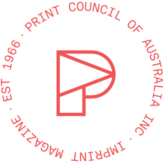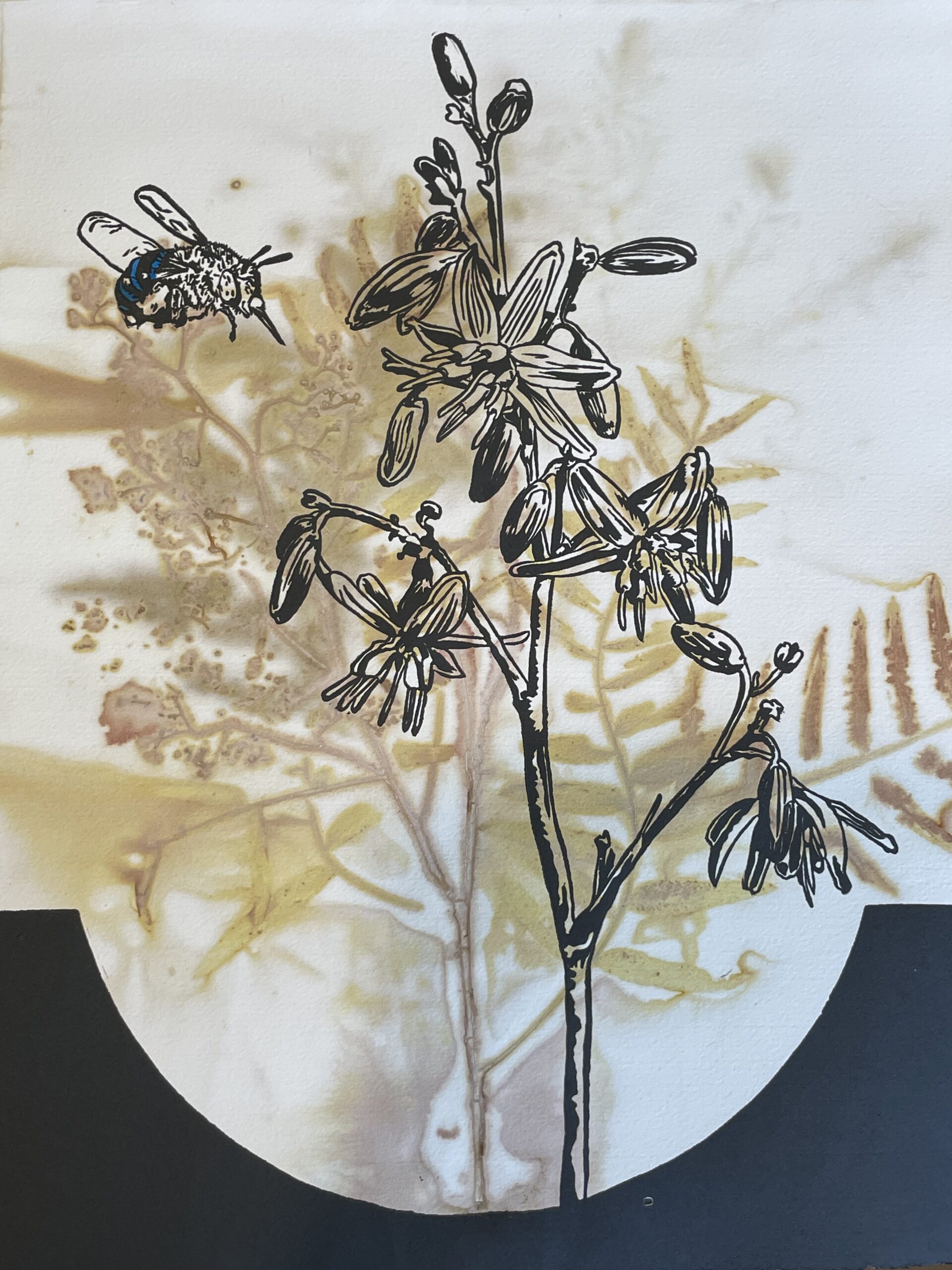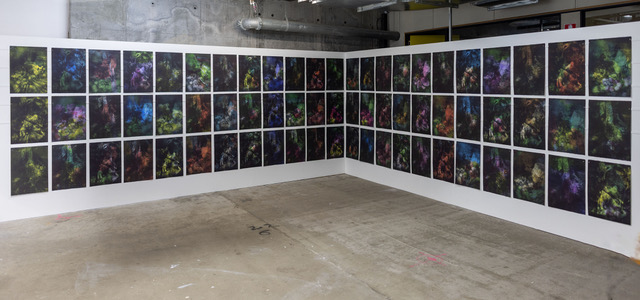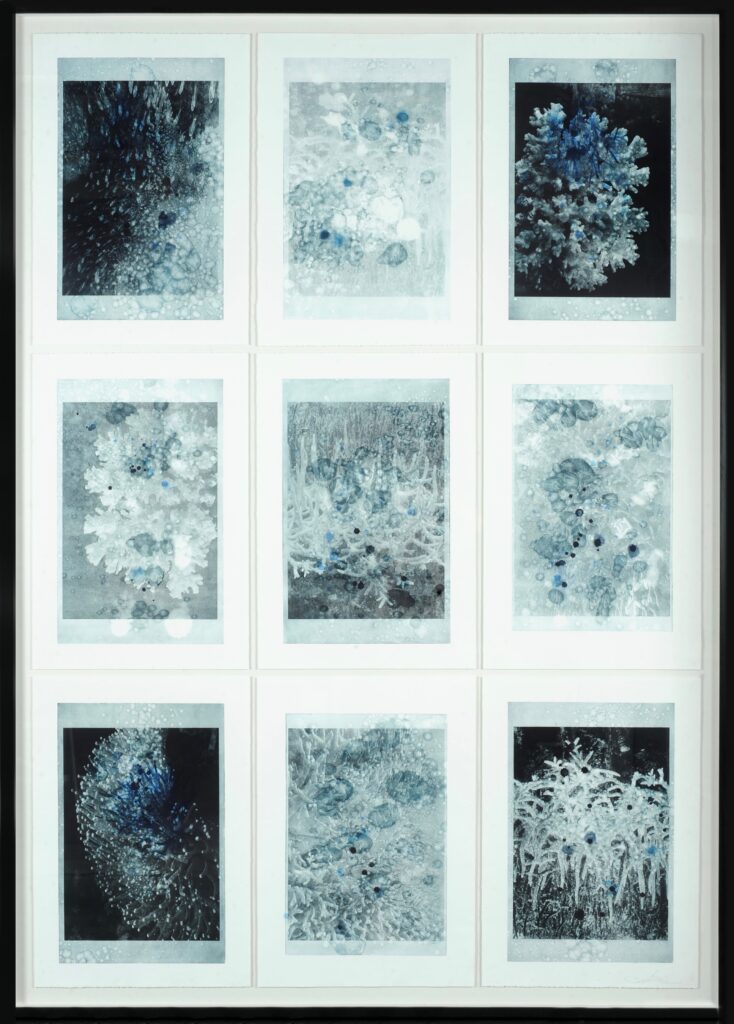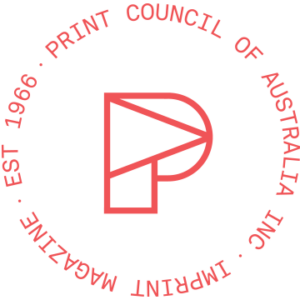Top:
Kate Gorringe-Smith, The Blue-banded Bee and the Flax Lily, 2024, hand-coloured linocut on ecoprint, 38 x 28 cm
Below:
Works by (top to bottom) Lana de Jager, Olivia Moroney and Mei Sheong Wong.
All images copyright and courtesy of the artists.
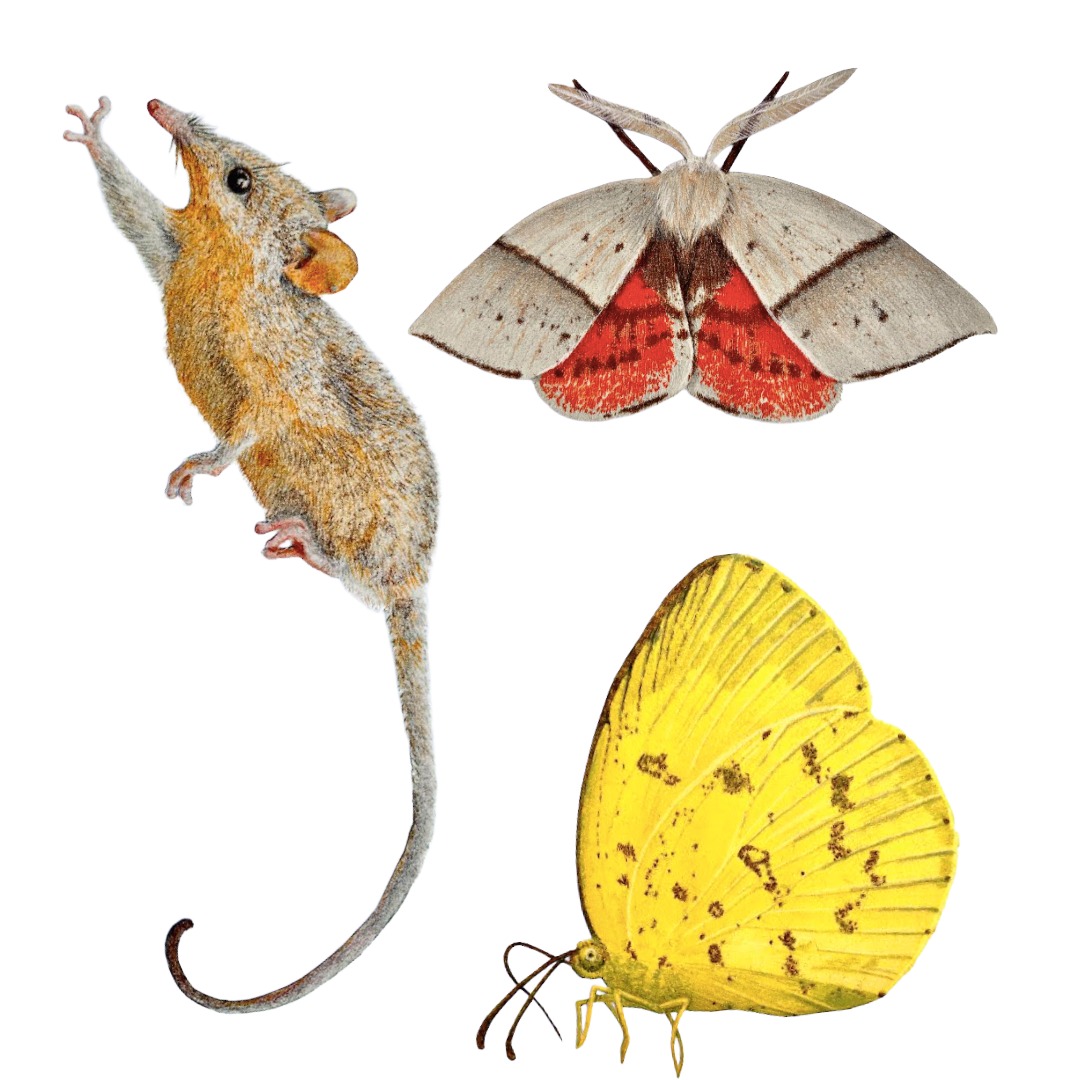
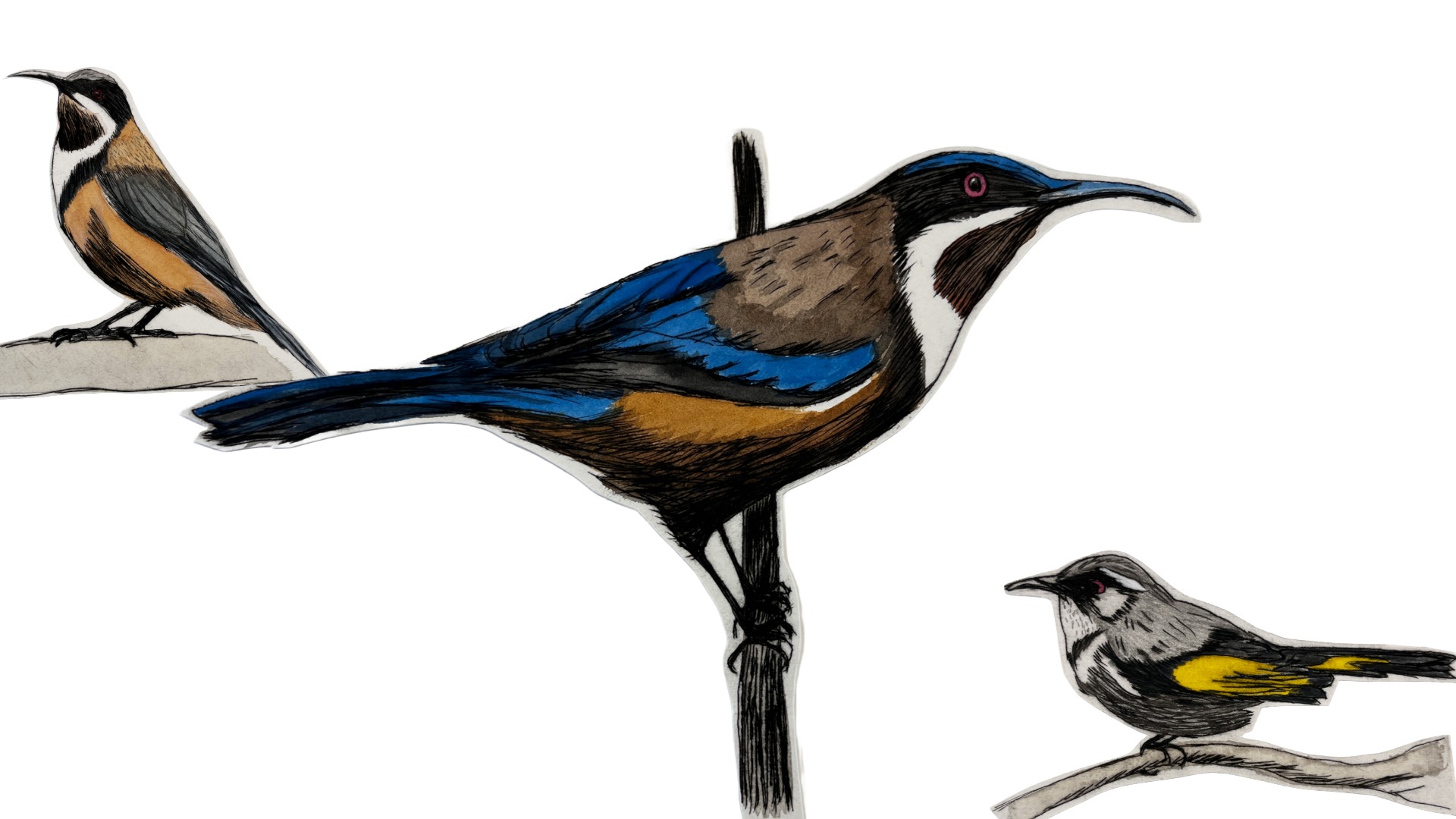

Pollinators is an invitation for printmakers to investigate the world of Australian native pollinators. The project, coordinated and curated by the Firestation Print studio and exhibited at the Print Council of Australia, has attracted contributions from all around the country. Artists were asked to find and research a native pollinator, make a print of it and then cut it out and send it to the Firestation to be part of a buzzing, humming, flapping, squawking installation of our lesser-known pollinators. Because when many of us try and think of a pollinator, all that comes to mind is the European Honeybee.
This struck me last year when I was fortunate to be involved in two art projects that brought some of the tinier beings on the planet to the fore. The first was a print project based in India. ‘The Sentience of Small Beings’ was the first project initiated by NAU (Nature Art Us) Foundation, a trans-disciplinary research organisation ‘dedicated to advancing ecological awareness through multidisciplinary creative practices’ (www.nau.org). NAU gathered two international collectives, printmakers and ceramicists, and tasked them with researching and creating work about the life of an insect. Our research was supported over a five-month period through online meetings and presentations by experts in various kinds of insect life.
As the representative Australian printmaker, of course I wanted to depict an Australian insect. So I began researching this world about which I knew so little. Turns out we have over 2000 native bee species! And only a few of them make honey or live in a hive! How exciting – here was a whole new world to discover, and bees were only one of many, many native pollinators.
I ended up making a print of a Blue-banded Bee, a native bee that is smaller than the honeybee and identified by bright blue stripes on its abdomen. I chose this little bee because I read that a local environmental group, the Merri Creek Management Committee, ran a successful campaign to plant Matted Flax-lilies along local waterways to provide habitat for the bees and to help save the lily, which is endangered. This species of lily requires a special kind of pollination, called ‘buzz-pollination’, that is carried out by native bees and in particular the Blue-banded Bee. The project embodied the kind of beautiful partnership that has evolved between pollinators and plants – the one providing food and the other providing the means of reproduction: a beautiful interdependence.
I was drawn to this story as I live close to where the Merri Creek flows into the Birrarung/Yarra River, and soon located clusters of these blue-flowered lilies. I then realised that I also had some of these lilies in my garden, and actually spotted my first Blue-banded Bee near a planting of the lilies by the river!
The NAU project was driven by the global decline in insect population, due to ‘intensive agriculture, commercial forestry with disregard to local flora, industry and urban development, changes in the way we manage our gardens, pesticides and herbicides, light pollution and other effects of climate change’ (NAU Artist Communication email 2024). At the heart of the project was the desire to instill a sense of wonder in the artists for these tiny and quite invisible creatures that we are threatening and yet depend on for so many things, including pollination, decomposition and pest control.
Like NAU, I am a great believer that art projects make a difference. In the cycle of the project being initiated, the artists invited, the works being made, and the public experiencing the exhibited works, there are so many points at which people can become engaged and ideas shared, amplifying the original premise of the project to spred wonder and awareness.
The second project I was involved in was an art-science residency at Macquarie University. I was paired with researchers Marie-Genevieve Guiraud and Andrew Barron whose work revolves around bee cognition and health.
When I visited their lab, Prof. Barron related how one of their challenges is to get people to recognise a bee as an individual being, not a multiple with a hive mind. A bee is an incredibly intelligent animal that makes choices, learns quickly and uses judgement in its daily life. To emphasise this I created an oversized portrait of an individual bee. Portraits traditionally depict human subjects, so I used that tradition to present the bee as a creature with personhood in its own right. In my print, the bee looks out at the viewer, challenging them to look it in the eye and consider it an equal.
This project was also fascinating, but did underscore how the honeybee dominated my concept of the pollinator. As I did more research about native pollinators I discovered that a great variety of insects and bugs are pollinators, along with many birds and mammals.
When I first approached the Firestation Print Studio to see if they were interested in a members’ project about native pollinators, I was hoping that our prints might be shown alongside the set of prints created for NAU’s Sentience of Small Beings project. Unfortunately the end date for that project had to be extended, but the Firestation project still went ahead! Director Liz McDowell was taken with the idea, and the Firestation had already the PCA gallery booked for the RSVP Project – a collaboration between the Firestation and NSW’s Southern Highland Printmakers. The Pollinators exhibition could go in the second gallery space, and by luck the booking coincided with Pollinator’s Week!
From there everything moved quickly. The exhibition would be in the style of the Wall of Wings – a print installation that is part of my Overwintering Project. Dreamed up in 2019 by local artist Penelope Lawry to be part of the Coffs Harbour Overwintering Project exhibition, the Wall of Wings is an installation of cut-out shorebird prints. This in turn was inspired by American artist Hilary Lorenz’s Moth Migration Project – where artists contribute printed or drawn cut out moths (mothmigrationproject.net). In the Wall of Wings, the multitude of prints creates a dynamic and breathtaking flock! To emulate the impression of the multitudes of small creatures that are so busily working to keep our plants blooming and fruiting, we have also asked the artists of Pollinators to cut their prints out, even though not all our native pollinators are airborne. It will be more of a scurrying, flapping, buzzing installation!
Thanks to the enthusiasm of the Australian printmaking community and the hard work of Liz McDowell and Fiona Davey at the Firestation, we have over 100 works for the exhibition by around 40 artists!
Just as my excitement to learn about the Blue-banded Bee led me down a rabbit hole of fascinating pollinator facts (did you know that beetles were probably the world’s first pollinators? That ‘Ornithophily’ is the pollination of flowering plants by birds? That insects can see ultra-violet light and so what looks like a plain flower to the human eye actually shows a pathway to the nectar through the insects’ eyes? But I digress….), I was thrilled to see the range of species that our contributing artists were drawn to, and to learn of their excitement as well.
Lana de Jager, for instance, chose to depict animals that she was surprised to discover were pollinators. She wrote, ‘I simply didn’t realise how many creatures did this amazing job! The Beautiful Leaf Moth: moths in general are known to pollinate plants with white or pale-colored, night-blooming flowers that produce ample nectar, such as morning glory, tobacco, and yucca. The Honey Possum is a crucial pollinator for many native species, including Banksia, bottlebrushes, kangaroo paws and grass trees. And the humble Common Grass Yellow Butterfly is an important pollinator of specifically the Arrowhead Violet, but also of wild herbs and shrubs, including Lavender, Salvia and Asters.’
In contrast, Tasmanian artist Olivia Moroney was immediately drawn to two local bird species with which she was already familiar. She wrote, ‘As soon as I saw this project was happening I knew I wanted to create some drypoint prints of birds. I have seen Kate’s Overwintering Project and I was very drawn to the idea. I was drawn to the Crescent Honeyeater due to its delicate feathers and splash of yellow mixed with a full spectrum of greys and blacks. I usually work tonally with aquatint and etching but for this project I used drypoint etching and hand coloured the prints. I enjoyed the process of replicating the colours in the birds after printing them. With the Eastern Spinebills, I wanted to create them due to their different tones of browns and splashes of blue. I was fascinated with the images of them I saw and the angles of their head and the changing colours.’
Focussing on these birds’ roles as pollinators has created a new connection between Olivia and these birds. She writes, ‘I am always looking for them in the landscape now…In my practice, I look at the landscape all over the state, but this was a lovely opportunity to consider another very important element of the environment.’
South Australian based Mei Sheong Wong had a different kind of connection with the tiny marsupials she chose to depict, writing, ‘I was born in Singapore, which has scant natural resources, unlike Australia! When I moved to South Australia some decades ago, I studied Natural Resource Management at Roseworthy College, north of Adelaide. Rose, one of my classmates, being Indigenous and very knowledgeable about ecology, took me along to a vegetation survey at Para Wirra Park. During the survey, Rose was delighted to find an Antechinus, which she showed me, explaining that this was a tiny Australian marsupial, and not a mouse! When I saw that Antechinus was on the list of Pollinator species, I decided to make an etching of it – in remembrance of how Rose (and other Indigenous folk I’ve met) taught me many things over time, and welcomed me to this land.’
For Pollinators I have also created prints of pollinators with which I have a connection – the Blue-banded Bee of course, but also species of bird that I find in my garden and the wonderful Grey-headed Flying Fox that lives along the banks of the Birrarung, hanging like strange fruit during the day and heading out on their leathery wings at dusk.
Learning about our native pollinators has been a process of learning to notice fresh entanglements between the human and more-than-human world. It has given me a deeper understanding of ways in which the world is entwined, to see new interdependencies and to appreciate different and older patterns of living. When I walk beside the Merri or the Birrarung I now keep an eye out for flowers that may be in bloom, and for their pollinators.
You can’t save what you don’t know. Globally, insect numbers are dropping. One in six of Australia’s birds is endangered and many of our mammals too. But learning to see is one of the most important steps in learning to care. And what does art do if not make things visible? I hope that the care the artists have put into researching and creating their prints for Pollinators also engages those who come to see the exhibition, and that people leave with a with a feeling of wonder, and maybe even a commitment to care.
—
Pollinators is at the PCA Gallery, Studio 2 Guild, 152 Sturt Street, Southbank, until 21 November, Tuesday- Saturday, 10am-4pm.
—
www.theoverwinteringproject.com
@kategorringesmith
—
Join the PCA and become a member. You’ll get the fine-art quarterly print magazine Imprint, free promotion of your exhibitions, discounts on art materials and a range of other exclusive benefits.
